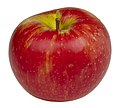Honeycrisp
Honeycrisp is a cultivar of apple that was developed at the University of Minnesota's Horticultural Research Center in the 1960s. It was introduced to the market in 1991 and has since gained popularity due to its sweet taste, firm texture, and long shelf life.
History
The Honeycrisp apple was developed by the University of Minnesota's apple breeding program, which began in the 1930s. The program aimed to develop new apple varieties that could withstand the harsh Minnesota winters. The Honeycrisp was created by crossing a Macoun with a Honeygold, both of which are descendants of the McIntosh apple.
Characteristics
Honeycrisp apples are known for their sweet, slightly tart flavor and crisp, juicy texture. They are medium to large in size and have a round shape. The skin is a distinctive mottled red over a yellow background, while the flesh is cream-colored. Honeycrisp apples are also known for their long shelf life, remaining fresh for up to seven months in refrigerated storage.
Cultivation
Honeycrisp apples are grown in various regions of the United States, including the Midwest, New England, and the Pacific Northwest. They are also grown in Canada, New Zealand, and parts of Europe. The trees are hardy and resistant to many common apple diseases, but they require careful management to produce high-quality fruit.
Uses
Honeycrisp apples are primarily eaten fresh, but they can also be used in cooking and baking. They make excellent applesauce and apple pie, and their sweet flavor and crisp texture make them a popular choice for salads and cheese plates.
Market
Since its introduction in 1991, the Honeycrisp apple has gained a significant share of the apple market. Its popularity is due in part to its flavor and texture, but also to its longer shelf life compared to other apple varieties. The Honeycrisp is often sold at a premium price, reflecting its high demand and relatively low supply.
| Apple Inc. | ||||||||||||||||||||||||||||||||||||||||||
|---|---|---|---|---|---|---|---|---|---|---|---|---|---|---|---|---|---|---|---|---|---|---|---|---|---|---|---|---|---|---|---|---|---|---|---|---|---|---|---|---|---|---|
* Italics indicate discontinued products, services, or defunct companies.
|
Transform your life with W8MD's budget GLP-1 injections from $125.
W8MD offers a medical weight loss program to lose weight in Philadelphia. Our physician-supervised medical weight loss provides:
- Most insurances accepted or discounted self-pay rates. We will obtain insurance prior authorizations if needed.
- Generic GLP1 weight loss injections from $125 for the starting dose.
- Also offer prescription weight loss medications including Phentermine, Qsymia, Diethylpropion, Contrave etc.
NYC weight loss doctor appointments
Start your NYC weight loss journey today at our NYC medical weight loss and Philadelphia medical weight loss clinics.
- Call 718-946-5500 to lose weight in NYC or for medical weight loss in Philadelphia 215-676-2334.
- Tags:NYC medical weight loss, Philadelphia lose weight Zepbound NYC, Budget GLP1 weight loss injections, Wegovy Philadelphia, Wegovy NYC, Philadelphia medical weight loss, Brookly weight loss and Wegovy NYC
|
WikiMD's Wellness Encyclopedia |
| Let Food Be Thy Medicine Medicine Thy Food - Hippocrates |
Medical Disclaimer: WikiMD is not a substitute for professional medical advice. The information on WikiMD is provided as an information resource only, may be incorrect, outdated or misleading, and is not to be used or relied on for any diagnostic or treatment purposes. Please consult your health care provider before making any healthcare decisions or for guidance about a specific medical condition. WikiMD expressly disclaims responsibility, and shall have no liability, for any damages, loss, injury, or liability whatsoever suffered as a result of your reliance on the information contained in this site. By visiting this site you agree to the foregoing terms and conditions, which may from time to time be changed or supplemented by WikiMD. If you do not agree to the foregoing terms and conditions, you should not enter or use this site. See full disclaimer.
Credits:Most images are courtesy of Wikimedia commons, and templates, categories Wikipedia, licensed under CC BY SA or similar.
Contributors: Prab R. Tumpati, MD

